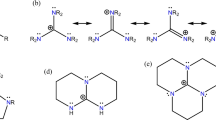Abstract
The crystal structure of the 2:1 proton-transfer compound of brucine with biphenyl-4,4 ′ -disulfonate, bis(2,3-dimethoxy-10-oxostrychnidinium) biphenyl-4,4 ′ -disulfonate hexahydrate (1) has been determined at 173 K. Crystals are monoclinic, space group P21 with Z = 2 in a cell with a = 8.0314(2), b = 29.3062(9), c = 12.2625(3) Å, β = 101.331(2)°. The crystallographic asymmetric unit comprises two brucinium cations, a biphenyl-4,4 ′ -disulfonate dianion and six water molecules of solvation. The brucinium cations form a variant of the common undulating and overlapping head-to-tail sheet sub-structure. The sulfonate dianions are also linked head-to-tail by hydrogen bonds into parallel zig-zag chains through clusters of six water molecules of which five are inter-associated, featuring conjoint cyclic eight-membered hydrogen-bonded rings [graph sets R 33 (8) and R 34 (8)], comprising four of the water molecules and closed by sulfonate O acceptors. These chain structures occupy the cavities between the brucinium cation sheets and are linked to them peripherally through both brucine N+–H···Osulfonate and Ocarbonyl···H–Owater to sulfonate O bridging hydrogen bonds, forming an overall three-dimensional framework structure. This structure determination confirms the importance of water in the stabilization of certain brucine compounds which have inherent crystal instability.
Graphical Abstract
The crystal structure determination of the 2:1 proton-transfer brucinium compound, bis(2,3-dimethoxy-10-oxostrychnidinium) biphenyl-4,4′-disulfonate hexahydrate shows the presence of two independent brucinium cations which form into semi-associated sheet substructures. The disulfonate dianions and the associated water molecules of solvation occupy the interstitial cavities between the brucinium substructures with which they are hydrogen-bonded, giving a three-dimensional framework structure.








Similar content being viewed by others
References
O’Neil MJ (2001). Editor. The Merck index, 13th edn. Merck and Co., Inc, Whitehouse Station, pp 708, 709, 1614
Peerdeman AF (1956) Acta Crystallogr 9:824
Gould RO, Walkinshaw MD (1984) J Am Chem Soc 106:7840
Białońska A, Ciunik Z (2006) Acta Crystallogr E62:o5817
Białońska A, Ciunik Z (2007) Acta Crystallogr E63:o120
Smith G, Wermuth UD, Healy PC, White JM (2006) Aust J Chem 59:321
Smith G, Wermuth UD, Young DJ, Healy PC (2005) Acta Crystallogr E61:o2008
Smith G, Wermuth UD, White JM (2007) Acta Crystallogr C63:o4276
Smith G, Wermuth UD, White JM (2007) Acta Crystallogr E63:o489
Smith G, Wermuth UD, Healy PC, White JM (2006) Acta Crystallogr C62:o203
Glover SBB, Gould RO, Walkinshaw MD (1985) Acta Crystallogr C41:990
Białońska A, Ciunik Z (2004) Acta Crystallogr C60:o853
Wilen SH (1972) In: Eliel EI (ed) Tables of resolving agents and optical resolution. University of Notre Dame Press, Notre Dame
Dijksma FJJ, Gould RO, Parsons S, Taylor J, Walkinshaw MD (1998) Chem Commun 745
Oshikawa T, Pochamroen S, Takai N, Ide N, Takemoto T, Yamashita M (2002) Heterocycl Commun 8:271
Smith G, Wermuth UD, White JM (2006) Acta Crystallogr C62:o353
Białońska A, Ciunik Z, Popek T, Lis T (2005) Acta Crystallogr C61:o88
Białońska A, Ciunik Z (2006) Acta Crystallogr C62:o450
Smith G, Wermuth UD, White JM (2005) Acta Crystallogr C61:o621
Swift JA, Reynolds AM, Ward MD (1998) Chem Mater 10:4159
Swift JA, Ward MD (1998) Chem Mater 12:1501
Holman KT, Ward MD (2000) Angew Chem Int Ed 39:1653
CrysAlis CCD and CrysAlis RED (2008) (version 1.171.32.5). Oxford Diffraction Ltd., Yarnton, England
Sheldrick GM (1996) SADABS: absorption correction program for area detectors. University of Göttingen, Germany
Altomare A, Cascarno G, Giocovasso C, Guagliardi A, Burla MC, Polidori G, Camalli M (1994) J Appl Crystallogr 27:435
Sheldrick GM (2008) Acta Crystallogr A64:112
Farrugia LJ (1999) J Appl Crystallogr 32:837
Flack HD (1983) Acta Crystallogr A39:876
Spek AL (2009) Acta Crystallogr D65:144
Acknowledgments
The authors acknowledge financial support from the Australian Research Council and the Schools of Physical and Chemical Sciences (Queensland University of Technology) and Biomolecular and Physical Sciences (Griffith University).
Author information
Authors and Affiliations
Corresponding author
Rights and permissions
About this article
Cite this article
Smith, G., Wermuth, U.D. & Young, D.J. Hydrate Stabilization in the Three-Dimensional Hydrogen-Bonded Structure of the Brucinium Compound, Bis(2,3-dimethoxy-10-oxostrychnidinium) Biphenyl-4,4′-disulfonate Hexahydrate. J Chem Crystallogr 40, 520–525 (2010). https://doi.org/10.1007/s10870-010-9689-7
Received:
Accepted:
Published:
Issue Date:
DOI: https://doi.org/10.1007/s10870-010-9689-7



